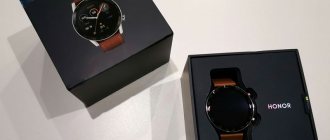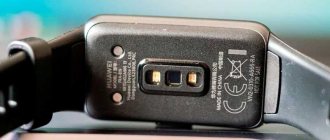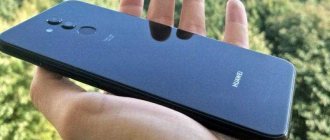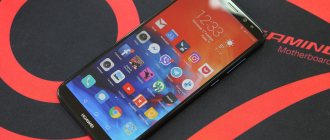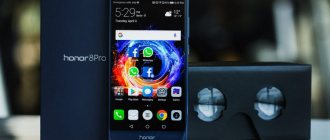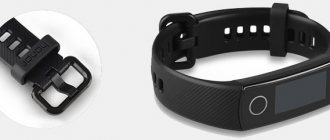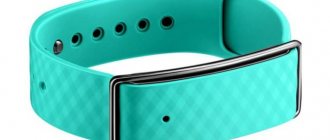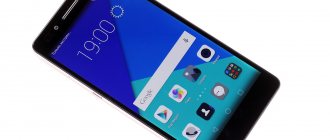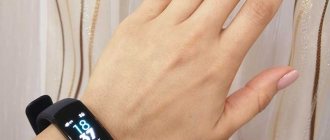Huawei Mate 9 Pro is an intermediate model between the Mate 9 and Porsche Design, which were presented in the fall of 2016. With the release of such gadgets, Huawei proves how much the company has grown in recent years. A premium device with a beautiful design, the latest hardware and well-optimized software - all this speaks for itself. The editors of the GSMArena portal prepared a review of this smartphone, and we translated it for our audience.
Subscribe to our Telegram
Specifications
- Screen: 5.5 inches, AMOLED, 534 ppi, 2560×1440 pixels, Gorilla Glass 3.
- Operating system: Android 7.0 Nougat (Huawei EMUI 5.0).
- Processor: Kirin 960, eight-core: 4×Cortex-A73 (2.4 GHz) + 4×Cortex-A53 (1.8 GHz).
- GPU: Mali-G71 GPU, eight-core.
- RAM: 6 GB.
- Built-in memory: 128 GB, no microSD card slot.
- Main camera: dual Leica certified - 20 MP (monochrome sensor) and 12 MP (color sensor); f/2.2, 4-in-1 hybrid autofocus, dual LED flash; Video recording 2160p at 30 FPS and 1080p at 60 FPS.
- Front camera: 8 MP (f/1.9), 1080p video recording at 30 FPS.
- Battery: 4,000 mAh, lithium polymer, non-removable.
- Dimensions: 152×75×7.5 mm.
- Weight: 169 g.
- SIM slots: 2 nanoSIM.
- Communications: LTE-A (up to cat. 12, 600 / 150 Mbit/s), USB Type-C, Wi-Fi a/b/g/n/ac, GPS / GLONASS / Beidou / Galileo, IR port, no FM radio.
- Sensors: light, gravity, proximity, gyroscope, digital compass, fingerprint sensor.
- Available colors: gold and black.
- Cost at the time of testing: about 50 thousand rubles on the gray market.
Compared to the regular Mate 9 (5.9 inches), the display is significantly smaller, but it is curved at the sides. Thanks to this, the Mate 9 Pro can be called a regular smartphone, and not a huge phablet. Many will be disappointed by the lack of a microSD card slot, but this is compensated by the presence of 128 GB of memory. There is also no protection against water and dust, as in other Huawei products - the company is still ignoring this technology.
Huawei Mate 9: first impressions
It is difficult to explain why it is necessary to do so in such detail - probably the company considered the presentation at CES ineffective. Or maybe something else will be brought to the largest tech exhibition early next year. Or Huawei believes that the information space needs to be blown up without stopping. Be that as it may, we meet Huawei Mate 9 – the company’s new flagship device.
No, far from being relegated to the discount section or retirement, these smartphones have completely different niches - the new product makes the Mate 8 model, presented just in January at CES, a thing of the past. But at its core, the Mate 9 carries an all-new HiSilicon Kirin 960 platform and the second generation of a dual-camera system developed jointly with Leica. Technologically, this is the company’s top device – and we were able to get acquainted with it shortly before the official announcement, which took place today in Munich.
Externally, the Mate 9 is almost identical to its predecessor - with differences in the form of a different camera module, in which two lenses are striking, and a display reduced by one tenth of an inch - but this is not striking at all. An unusual for Huawei round fingerprint scanner, an almost complete absence of frames around the screen, a metal body in soothing colors, a standard arrangement of hardware keys (both on the right side) and an inscription with the name of the manufacturer at the bottom of the front panel - everything remains as it was. Surprisingly, the resolution of the large screen has not changed – it’s still Full HD. One could say that the Chinese are true followers of traditions if it were for the Mate 9 Porsche Design.
| Huawei Mate 9 | Huawei Mate 8 | |
| CPU | HiSilicon Kirin 960: eight cores (4 × ARM Cortex A73, 2.4 GHz + 4 × ARM Cortex A53, 1.8 GHz), ARM Mali-G71 graphics core | HiSilicon Kirin 950: eight cores (4 × ARM Cortex-A72, 2.3 GHz + 4 × ARM Cortex-A53, 1.8 GHz), ARM Mali-T880 MP4 graphics core |
| Display | LCD, IPS, 5.9 inches, 1920 × 1080 | LCD, IPS, 6 inches, 1920 × 1080 |
| RAM _ | 4/6 GB | 3/4 GB |
| Flash memory | 32/64/128 GB + microSD slot | 32/64 GB + microSD slot |
| SIM cards | Two nano-SIMs, the second slot is combined with a memory card slot | Two nano-SIMs, the second slot is combined with a memory card slot |
| Wireless modules | Wi-Fi (802.11ac/b/g/n), Bluetooth 4.2, NFC, IR port | Wi-Fi (802.11ac/b/g/n), Bluetooth 4.2, NFC |
| LTE | LTE Cat.12 (up to 600 Mbps): bands 1, 2, 4, 5, 6, 7, 8, 9, 12, 17, 18, 19, 20, 26, 38, 39, 40, 41 | LTE Cat. 6 (up to 300 Mbit/s): bands 1, 2, 3, 4, 5, 6, 7, 8, 12, 17, 19, 20, 26, 38, 39, 40 |
| Camera | Dual, 12 megapixel + 20 megapixel, f / 2.2, optical stabilizer, 2x optical zoom | 16 megapixels, f/2.0 optical stabilizer |
| Front-camera | 8 megapixels, autofocus | 8 megapixels, fixed focus |
| Fingerprint scanner | Eat | Eat |
| Connectors | 3.5 mm audio jack, USB Type-C (USB 2.0) | 3.5 mm audio jack, microUSB (USB 2.0) |
| Battery | 15.2 Wh (4000 mAh, 3.8 V) | 15.2 Wh (4000 mAh, 3.8 V) |
| Weight | 190 grams | 185 grams |
| operating system | Android 7.0 Nougat with proprietary EMUI 5.0 shell | Android 6.0 Marshmallow with proprietary EMUI 4.0 shell |
| Huawei Mate 9 from all sides | ||
I’ll say literally one line about the Mate 9 Porsche Design – the device itself has not yet been seen at the company’s representative office, but some of its characteristics have been “shown.” It received a curved 2K display (the exact resolution is unknown) with a diagonal of 5.5 inches - and, most likely, it will be AMOLED. The Full HD bastion represented by Huawei has fallen. It also supports the Google Daydream VR virtual reality headset and has a large amount of flash memory (up to 256 GB). Otherwise, the Porsche Design version is technically identical to the “regular” Mate 9.
This means it is no less technically interesting. Both Mate 9 debut the new proprietary Kirin 960 system-on-chip, which, in turn, uses ARM Cortex-A73 cores made using a 10nm process technology for the first time in the world. In theory, the clock speed of these cores can reach 2.8 GHz, but in this case it is limited to 2.4 GHz. Compared to Cortex-A72, it is claimed to achieve a 30% increase in performance with the same increase in energy efficiency. Together with four such cores, the new platform runs four well-known ARM Cortex-A53 clocked at 1.8 GHz. The latest Mali-G71 accelerator is responsible for the graphics - again, it is used here for the first time in the world. Unfortunately, I did not have the opportunity to measure the system's performance - for this I will have to wait for full testing.
The device will receive 4 or 6 GB of RAM and 32/64/128 GB of flash memory - today this is the standard for flagship smartphones. The new platform supports LTE category 12 with a theoretical data transfer rate of 600 Mbps. All bands necessary for the correct operation of 4th generation networks are available. There are a lot of wireless modules: in addition to dual-band Wi-Fi (which is important for Huawei to mention, the company does not always use it in its smartphones) and Bluetooth 4.2, there is also NFC and even an infrared port.
The battery is the same as in the Mate 8 - 4000 mAh, but Huawei promises better energy efficiency, declaring up to two days of battery life, and also offers a new generation of SuperCharge fast charging. According to the manufacturer, when using a proprietary charger, the smartphone will receive enough energy in 20 minutes to last for a day of operation. Of course, the USB Type-C port is used here – but of the 2.0 standard.
An equally important update has been made to the camera - the Mate 9 has received the second generation of a dual-camera system that carries the Leica banner above it. Apparently, the principles of its operation have not changed, despite the fact that now the two modules differ in resolution: one is, as before, 12-megapixel, the other is 20-megapixel. In theory, they should provide 2x “optical” zoom – but the principle here is different than Apple’s iPhone 7 Plus. The lenses here do not differ in focal length, but the zoom is available exclusively in 20-megapixel mode. A “zoom” slider appears on the screen, but when it is activated, the usual digital zoom with a crop of the image is triggered.
Above you can see examples of how the Huawei Mate 9 zoom works - rather disappointing and familiar digital zoom technologies from many generations. There is quite a big gap between the promise and reality. I have only one explanation for this - crude software and filling of a pre-production sample, perhaps while the zoom is simply not working correctly. Another explanation – that Huawei is throwing dust in our eyes – somehow I don’t really want to believe. Again, it’s worth waiting for the production sample.
| Examples of shooting with the main camera of Huawei Mate 9 | ||
But overall the camera seems to be excellent. Thanks to the use of a 20-megapixel RGB sensor, detail has been increased, a much-needed optical stabilizer has been added, and the advantage of the previous dual-camera module in the form of extended dynamic range has not gone away. Autofocus is hybrid, using both phase and contrast sensors with laser distance detection. The optics, judging by the aperture (f/2.2), are the same.
The interface has the same fonts, the camera has a monochrome mode, proprietary filters - we have already seen all this in the P9. It also has software background blur, post-focus, and the ability to record 4K video.
An example of shooting with the front camera of Huawei Mate 9
The front camera has the same resolution as before - 8 megapixels, aperture is f/1.9. But autofocus has been added - selfies come out very decent.
Huawei Mate 9 will be released on Android 7.0 Nougat, thus becoming one of the first smartphones with the new version of Google's operating system. And the very first - with a new version of the proprietary shell EMUI 5.0. Judging by first impressions, visually it is almost no different from the fourth version. There are probably a lot of minor improvements - but again, we will only learn about them when we get to know the system in more detail.
The Mate 9, like the Mate 9 Pro, should go on sale in November at a price of about $1,000. No one can yet announce Russian prices and dates for the smartphones to go on sale. How can we guarantee the official appearance of these devices in our country? It is possible that they will never reach us, like, for example, nova Plus or Mate S.
Equipment
Huawei Mate 9 Pro comes in packaging that leaves no doubt about the premium nature of the gadget. Opening the beautiful black box with the Huawei and Leica logos, we are immediately presented with the smartphone itself in all its glory. Below it, in two compartments, there is a powerful 22.5 Watt charger, a proprietary USB Type-C cable, an adapter from microUSB to USB Type-C, headphones, a SIM card ejector and a silicone case.
Memory and performance
The main characteristics of Huawei Mate 9 Pro also attract attention. The device is built on a very productive platform. The basis of the gadget is the Kirin 960 processor. This is an eight-core solution, the most powerful that the company can offer at the moment. The CPU is capable of operating at frequencies up to 2400 MHz, which is a lot, considering that we are not holding a laptop, but a smartphone.
The Mali G71 is built in as a video accelerator. Fans of mobile entertainment can rest assured: all games will run at maximum graphics settings. Even the most demanding and heavy applications launch in seconds. You also don’t have to worry about throttling; no problems with overheating have been noticed with this platform.
The starting version has 4 Gb of RAM and 64 Gb on board. The more powerful version comes with 6 Gb of RAM and 128 Gb of ROM, respectively.
Important! A small drawback may be the lack of a slot for a memory card: the preset capacity cannot be further increased. However, for most everyday needs, the specified volume is quite enough.
The smartphone scored 130,000 parrots in Antutu. In some benchmarks, the device confidently outperforms even the iPhone7+. In general, the technical parameters of the phone are impressive; it is a very powerful gadget. Having such a device, you definitely don’t have to think about the power reserve.
Appearance
Left - Mate 9 Pro, right - Mate 9
Despite the fact that the Huawei Mate 9 Pro does not receive the Porsche Design nameplate on the front panel, the smartphone still boasts a stylish appearance. The display, curved on the sides, immediately attracts attention. Together with the Home button on the front panel, the result is almost an exact copy of the Samsung Galaxy Note 7. Huawei’s desire to lure away the audience of Samsung phablets is quite logical, because the last model in the Galaxy Note line was, to put it mildly, a failure.
Left - Mate 9 Pro, right - Galaxy S7 Edge
There is a large 5.5-inch screen on the front panel. Above it is a speaker. A light sensor is hidden under its mesh. To the left of the speaker grid is a small black dot called the proximity sensor. There is also an LED sensor for notifications and a front 8-megapixel camera.
Below the screen are three pressure-sensitive Android control buttons. In the middle is the Home button, which is not a button at all. You can't press it - it's a small touch screen that responds to taps. A very fast fingerprint scanner is integrated into this “button”.
The Home button can be customized to your liking. For example, you can turn off the two illuminated buttons on the sides and leave only one. Using it, you can perform the actions of the other three: one tap goes back, a long tap goes to the desktop, a gesture to the left or right will open a list of recent applications. Made in the style of the Meizu mTouch button, but only even better.
On the left side there is a tray for nanoSIM cards, on the right there are buttons for volume control and locking. There is only one infrared sensor on the top side, but the bottom is quite crowded: a USB Type-C port, a speaker grille and a 3.5 mm analog audio jack.
And finally, two camera sensors are located vertically on the back cover - a 12-megapixel color and a 20-megapixel monochrome. They are helped by a laser and a two-tone flash.
While the front panels of the Mate 9 Pro and Galaxy S7 edge are almost identical, the back covers are completely different. All because of the dual camera and plastic strips for antennas. The latter resemble HTC flagships. The back panel material is also completely different, even compared to the regular Mate 9 - it's polished metal with a “cleaned” texture. It is very pleasant to hold the device in your hand.
From a design point of view, Huawei Mate 9 Pro is far from original, but the Chinese have worked hard on the body materials and ease of use - all of this is top notch.
Huawei Mate 9: a long-lived giant
This year, Samsung rushed to announce the Galaxy Note 7 and screwed it up. Many people were waiting for it, talking with my friends, I saw people grieving that Samsung this year deprived the joy of forfeiting a flagship with a stylus. In response, I said that there are enough alternatives. Samsung is not the only one on the top-end Android market, but they told me that this is not the same. Here, they say, Note is the very best that can be.
In disputes, truth is born, so having walked around with Huawei Mate 9, I can now talk about it, explaining why the place on the market is never empty and how to choose an alternative to the Korean flagship. At the same time, you can think about whether it is rational to buy an expensive Chinese smartphone instead of a Korean one, if we are already talking about purchasing such a device.
No design
If I were Huawei, I would think twice and still implement original features in the Mate series, so that the smartphones do not look like inexpensive Xiaomi ones for $200. You pick up a phone and don’t understand how much it costs, top-end or budget, everything is mixed up.
My test Mate 9 has the original coating, it looks like there is a shipping film stuck to the back of the phone, but in fact there is nothing there. This is such an unusual lacquered finish combined with a metal body. From the outside it looks like metal, but in the hands it feels different, like ceramics.
If you want something like that, they will sell the Porsche Design version for 1,400 euros. I haven’t seen it in person, I can’t say how well it matches the price. But if you want the “expensive-rich” option, here is a candidate for transferring the amount from a bank card.
The fingerprint scanner works great, but is located on the back, so it’s not easy to unlock the phone when it’s lying on the table; you’ll have to turn the device over. The scanner is also responsible for other actions: it helps to pull out the curtain with notifications, scrolls through photos in the gallery, turns off the alarm clock, and helps answer calls.
To summarize, I will say that for such a healthy device, the smartphone turned out to be convenient, there is no talk of one-handed operation, but there is no feeling that you are walking around with some unrealistically “shoveled” phone.
Huge screen
The display of the Mate 9 is huge – 5.9 inches, but the smartphone is not that big; it is comparable in size to an iPhone with the Plus prefix. Yes, the Chinese know how to wisely use free space, cutting down the frames around the screen, while Apple mercilessly exploits its own design from three years ago.
The screen has very narrow frames, small margins at the top and bottom, and there are no buttons under the display. Despite this, no errors occur during use, and there are no random triggers. In general, this giant turned out to be easy to use, the body is not slippery, it’s comfortable to hold and pleasant to use.
Huawei Mate 9 has a good old IPS display with calm colors and tones. You can watch videos on it for hours, read texts - your eyes don’t get tired, unlike AMOLED, which some users complain about. The display is very bright and contrasty, even black looks very good here. The only thing I can complain about is the resolution, here it is 1920x1080 pixels. Few? The dot density is 373 ppi, if numbers are important to you, the picture is smooth, the fonts are clear, everything is as it should be.
If you don’t chase pixel density, doing meaningless things, but proceed from harsh realities, then this is enough, and the load on the system is less. Thanks to this, the Mate 9 lasts a very long time, but we'll talk about that later.
Chinese power
Huawei is the only Chinese company that puts its own processors in its devices. It does not buy developments from Qualcomm, MediaTek or Samsung, but tries to compete on the same level as its competitors, using its own chips.
A few words about the hardware, the Mate 9 has the top-end Hisilicon Kirin 960 with 4/64 GB of memory and good graphics, it doesn’t lag at all. But I didn’t expect anything else from the flagship.
I note that Mate 9 comes in different versions. The basic one gets 4/64 GB of memory and a 5.9-inch screen with Full HD resolution. There will be a Mate 9 Pro version with 4/64 or 6/128 GB of memory and a curved 5.5-inch QHD screen. There is also the Mate 9 Porsche Design - like the Mate 9 Pro, but in black. In my opinion, it’s too much and I can’t immediately understand why there are so many modifications.
Instead of a second SIM card, you can install a microSD card; the headphone jack is located at the top end. Not a very convenient place, but there are no restrictions on connecting a headset. The sound in the speakers is very clear and loud, the phone plays even low frequencies well, the earpiece takes on the role of a second source in stereo mode, complementing the one on the bottom.
Among the useful things there is an infrared port and NFC support. Recording telephone conversations did not work in my sample, perhaps it depends on the firmware.
The camera is not top-end, but high quality
The phone takes excellent shots during the day, at night and in the evenings, when there is little light, the photos will be worse, but the optical stabilization works very well. It feels like the pictures are of the same quality as those on the previously tested Huawei P9 Plus, which has a similar system of two cameras: one color, the other black and white. But here, instead of two 12 MP modules, there is a pair of 12 MP color and 20 MP black and white.
I will say that if you are looking for a phone with an ideal camera in this format, look towards the Google Pixel XL, Apple iPhone 7 Plus or Samsung Galaxy S7 edge.
The Huawei Mate 9 doesn't take photos as well as these devices. Autofocus works slower here, and the two-camera system works noticeably worse when games with depth of field begin. And even in poor lighting, noise is noticeable and details disappear, there are mistakes with the white balance, the picture is “blue”.
Alternatively, you can try the manual mode, but I advocate smart automation so that it can get itself out of difficult situations. There is still some work to be done here, but if you wish, turn on the manual mode in the camera and decide for yourself how you need to shoot in the current conditions. You can see examples of filming on Google Drive.
Long-playing
Huawei Mate 9 lasts longer than any flagship I've ever owned. Longer than iPhone 7 Plus, Google Pixel XL, OnePlus 3T or Samsung S7 edge. If all of them usually shrink by the end of the day with active use, then the Mate 9 withstood 1.5 days under the same load.
Yes, there are now plenty of Android phones on sale that last a long time, but usually they are middle class with capacious batteries. You won’t be able to find a similar device with a huge screen and the same hardware; the Mate 9 is unique in its own way.
You don’t have to charge it all night, it has fast charging, it charges 50% in an hour, and the whole process takes 1.5 hours.
Alternatives
It’s a pity, but the Galaxy Note 7 has left the race, otherwise it would have become the main contender for the title of Android Tsar of the Year. Alternatively, you can look towards the S7 edge, the same thing, except without the stylus. An excellent option - but expensive - is the Google Pixel XL, it has a unique design, and the camera works great, in addition, it is pure Android without the admixture of third-party shells. Other phones? And there are no other analogues of the same level on Android.
How much money
In America, the phone costs under $800, playing in the same league with other top competitors. I note that the rest of the Chinese brands are barred from going there; Xiaomi, Lenovo or Oppo in America do not know and do not risk venturing into such luxurious territory.
Is the Mate 9 worth considering? Yes, of course, if the budget allows, then it can and should be considered as a candidate for purchasing a top-end Android smartphone without significant drawbacks. Excellent battery life, sound, high-quality screen, sensitive scanner, modern hardware, the camera would still be brought to the same condition as Samsung and HTC did. She is very good, but there is very little left to ideal.
I began the text by saying that connoisseurs of large Android smartphones were sad when they learned that the Galaxy Note 7 would never reach Russian stores. Here is a good alternative, I would pay attention to the Mate 9, I liked the phone.
Yes, it is expensive, but purebred Google smartphones are also not cheap, to put it mildly. The Pixel XL will have a better camera, but the phone's operating time will be shorter. Not everyone needs a perfect camera, but the need to charge the phone less often is in demand much more often. I don’t think there will be queues for the Mate 9 and the phone will sell like pie. Huawei simply says that it can make devices of the same class and quality as Samsung, HTC or Apple, setting a price tag corresponding to the class.
Display
The 5.5-inch AMOLED matrix with curved edges is the key feature of the gadget. The screen is 0.4 inches smaller than the regular Mate 9, but the resolution has increased to 2560x1440 pixels and with it the pixel density to 534 ppi.
The matrix shows very good test results. For example, the average color difference value (DeltaE) is 3.8, but the colors themselves are not as sharp. Blues and reds stand out more (Delta E 8.1).
Contrast is high, as you would expect from an AMOLED at a maximum brightness of 366 nits. Another positive point is the low brightness threshold - only 4 nits. This will allow you to read comfortably in dark rooms.
Unfortunately, although the matrix in the Mate 9 Pro is created using AMOLED technology, the pixels in the pure black picture are not completely turned off. Now this is done in many gadgets, mainly so that the matrix does not burn out. Overall, the Mate 9 Pro's screen is slightly worse than the original model.
The contrast ratio in sunlight is a little disappointing, but by and large the display performs well outdoors. If you also use a proprietary film to reflect sunlight, then it’s generally at the level of other flagships.
Screen Features
The Huawei Mate 9 Pro display is one of its distinctive elements - it is a full AMOLED with a diameter of 5.5 inches . The rounded edges of the screen immediately attract attention. This technological solution is not only a design element, but also additional functional space.
Important! The screen resolution is one of the highest in this segment, 2560x1440. The clarity of the picture, especially at the very beginning of use, can surprise even an experienced user.
Protection against damage and scratches is made using third generation Gorilla Glass technology. The matrix transmits colors with virtually no distortion. The brightness of the color palette is worthy of special praise. Contrast rendering is in no way behind color rendering. Both of these features are customizable. The screen is an excellent example of an exemplary flagship solution, where each element fully fulfills the investment in it.
Battery
The Mate 9 Pro is noticeably smaller in size than the Mate 9, but this does not affect the battery capacity. This is still the same 4,000 mAh, which, coupled with the AMOLED screen, showed a good 87 hours according to the results of proprietary GSM Arena testing. This time includes routine tasks: talking on 3G, surfing the web, playing videos and normal standby.
A few words about the process of charging the gadget. The smartphone is equipped with a fairly powerful charger, capable of delivering current in several modes: 5V / 4.5A, 4.5V / 5A and 5V / 2A with a maximum power of 22.5 Watts. Only OPPO with their VOOC series chargers and Motorola with a 25 Watt TurboCharger are higher. To charge your Mate 9 Pro as quickly as possible, you need to use the original charger and the included USB cable. If original accessories are used, the purple indicators on the charger will flash.
If you replace the cable, you will have to be content with only 5V / 2A, but this is not the worst outcome of events. In some cases, you can even get stuck at 1A at 5V. It is noteworthy that the original USB Type-C cable from Huawei has additional connectors. This means that the battery inside the smartphone is most likely divided into two parts, and they are charged separately. There is nothing wrong with this except that a non-original charger will be much slower.
Huawei Mate 9 Pro charges very quickly - in just 13 minutes to 55% from zero. During the process, the case heats up slightly, but then cools down quickly.
Huawei Mate 8 review
Huawei Mate 8 is a phablet for the business segment. This is evidenced by the design, capabilities, and even the 6-inch display size. The model replaced the previous iteration of the devices. The developers themselves claim that they did not seek to redesign the appearance of the gadget. It's more about fixing bugs and updating the extremely successful Mate 7.
What characteristics does the refreshed Mate 8 have and is it worth paying attention to it?
Net
Huawei Mate 9 Pro supports LTE-Advanced, LTE Category 12 (Cat.12) with a theoretical download speed of 600 MB/s and upload speed of 150 MB/s. There are also 20 LTE bands, 6 3G bands and standard four-band 2G.
Wi-Fi support is full and dual-band with all modern standards (a/b/g/n/ac). There is Wi-Fi Direct and Internet distribution via an access point. There is also Bluetooth 4.2, A-GPS, GLONASS, Beidou (Chinese navigation system) and Galileo (European system). In addition to everything, there was still room for NFC and an infrared transmitter.
The USB Type-C connector transfers data only according to the USB 2.0 standard, that is, in theory, about 480 MB/s. As already mentioned, there are additional connectors for fast charging. Headphone owners will be happy with the good old 3.5mm audio jack, but many will be disappointed by the lack of FM radio.
Software
The device runs Android 7.0 Nougat operating system with Huawei's EMUI 5.0 shell installed on top. The latest version of the add-in has adopted all the features of previous versions and also introduced some innovations.
Getting to know the shell begins with a very nice lock screen. The wallpaper on it changes every day and is loaded automatically via Wi-Fi. By swiping up from the bottom on the lock screen, a menu with quick functions is pulled out: voice recording, calculator, flashlight, timer and QR code reader. With simple movements you can launch the camera. Most users are unlikely to look at the lock screen wallpaper for a long time due to the fast and convenient fingerprint scanner.
The shell supports multiple accounts. There is a so-called private space, which is protected by a fingerprint scanner. Thanks to support for multiple accounts, you can keep several copies of one application on your device, for example, two Facebook for different accounts.
The interface can be easily changed using themes - they can be downloaded from the appropriate directory.
The notification and quick actions panel has undergone almost no changes, but Huawei has added a convenient feature to it - switching automatic brightness adjustment. Google still can't figure it out. The recent applications menu hasn't changed either.
For use in a car, a special interface mode is provided, when all elements turn into tiles - a kind of Windows Phone style. For people with vision problems, there is a function to reduce or enlarge the interface - by default this option is set to medium.
A distinctive feature of the Huawei EMUI shell is its advanced control over notifications. You can prevent certain programs from sending certain types of reminders. The Chinese did this even before Google. The same can be done with Wi-Fi access - it often saves a lot of data. There is also some junk - there is an optimizer and an antivirus from Avast.
To save battery power, there is a hardcore mode that disables almost all functions of the smartphone, except for a few icons on an all-black desktop.
In the settings you can play with the soft-touch buttons for controlling the Android operating system. There is also a very useful feature for one-handed operation - a special button that can be placed anywhere on the screen. Clicking on it opens a menu with virtual analogs of “Back”, “Home” and “Recent applications”.
Other cool features of the firmware: gestures for performing different actions, multi-window mode for working with two applications at the same time, and hands-free voice control.
Iron
The “heart” of Huawei Mate 9 Pro is the Kirin 960 of its own production. The same chip is found in the original Mate 9. This processor was created by HiSilicon. It has long been owned by Huawei and supplies the Chinese giant with good chips. The processor is built on a 4+4 principle: four Cortex-A73 cores at 2.4 GHz for complex tasks and four more Cortex-A53 at 1.8 GHz for background processes. Cortex-A73 cores consume 30% less power than the previous generation Cortex-A72, but at the same time offer increased power.
The chip showed widely varying results in different benchmarks. For example, the popular Geekbench 4 multi-core test put the Mate 9 Pro in second place among all smartphones - only the regular Mate 9 is higher (most likely due to the lower resolution). But in the single-core test, the Kirin 960 was inferior to the iPhone 7 with its A10 Fusion chip.
The graphics in the Mate 9 Pro are handled by the Mali-G71MP8, one of the latest chips from ARM. Compared to the original Mate 9, there is a significant drop in graphics performance - all due to the resolution of 2560x1440 pixels. However, the chip itself performs well - on par with other flagships with similar screens.
As a result, we get one of the most powerful processors on the market at the moment. Huawei proves that it is not in vain that it follows its own path and invests money in creating its own chipsets.
Huawei Mate 9 Pro results in AnTutu Benchmark
In the popular AnTuTu benchmark, the Huawei Mate 9 Pro smartphone scores an average of about 155,174 points. This figure, like all those given below, was taken from the official website of the developer of this software.
Comparison with other smartphones from the ratings of different years
| Model | Platform | Memory | CPU rating | UX assessment | 3D assessment | Overall rating | |
| 1 | Samsung Galaxy S7 (SM-G930S) | Snapdragon 820 | 4 Gb + 32 Gb | 61437 | 38401 | 51768 | 158804 |
| 2 | Samsung Galaxy S7 (SM-G930F) | Snapdragon 820 | 4 Gb + 32 Gb | 61499 | 38334 | 51936 | 158723 |
| 3 | Samsung Galaxy S7 (SM-G930U) | Snapdragon 820 | 4 Gb + 32 Gb | 49413 | 37832 | 64539 | 158651 |
| 4 | OnePlus 3 | Snapdragon 820 | 6 Gb + 64 Gb | 34434 | 51956 | 62302 | 158616 |
| 5 | Huawei P10 | HiSilicon Kirin 960 | 4 Gb + 64 Gb | 55108 | 40898 | 51244 | 158356 |
| 6 | Xiaomi Mi 5 | Snapdragon 820 | 4 Gb + 128 Gb | 53399 | 36658 | 61322 | 158067 |
| 7 | Lenovo ZUK Z2 Pro | Snapdragon 820 | 6 Gb + 128 Gb | 50448 | 36410 | 63749 | 157958 |
| 8 | Xiaomi Mi Mix | Snapdragon 821 | 6 Gb + 256 Gb | 57026 | 36279 | 57064 | 157865 |
| 9 | Samsung Galaxy S7 Edge (Exynos 8890) | Exynos 8890 | 4 Gb + 32 Gb | 59354 | 39488 | 52327 | 157319 |
| 10 | LG G6 | Snapdragon 821 | 4 Gb + 32 Gb | 53330 | 34956 | 62691 | 156293 |
| 11 | Huawei Mate 9 Pro | Kirin 960 | 6 Gb + 128 Gb | 53310 | 40387 | 49885 | 155174 |
The rating of devices on the official AnTuTu website is updated once a month. Old data is available via Web Archive.
Top
Calls and applications
The Mate 9 Pro's calling app is tightly integrated with Contacts. Nothing supernatural, but all the important things are in place. I was pleased with the noise filtering function when the main speaker is on.
The settings section for two SIM cards allows you to rename them and mark which one you are using to make calls. The interface hints that even if 4G can only be used on one card, 3G is active on both.
The speakers in the device are quite loud, just like the original. Even at maximum volume there is no distortion or noise. Something like a stereo effect is used: the main speaker is complemented by a conversational one. This stereo effect only works in landscape orientation, so when changing position, the music often pauses for a short time - over time, it gets annoying.
Based on the results of GSM Arena testing, the Huawei Mate 9 Pro speakers showed the following volume results:
- Voice - 67.2 dB.
- Music - 72.4 dB.
- Incoming call alert - 79.5 dB.
- The overall result is very good.
The smartphone comes with several pre-installed applications. Among them: a WPS office suite, a Health program for collecting physical activity data, a full-fledged file manager, a compass, audio recording (with additional settings for better quality from multiple microphones) and a flashlight. Of course, there is an application for using the infrared transmitter. The Smart Controller program will allow you to control most TVs via your phone.
Multimedia and audio
The firmware has a good Gallery application installed. It has several sorting features and even secret albums. Each picture can be rotated. There is a built-in editor with a good set of functions: changing the light level, editing exposure, adding filters and other features.
The video player is quite simple. Among the functions we can highlight only setting the playback speed and a “floating” window for viewing videos on top of other programs.
The music player is very stylish and pleasant in terms of features. By default, it has four playlists by which songs are sorted: songs, artists, albums and folders. You can create your own playlist with a different sorting. The appearance of the program dynamically changes in accordance with the album cover - just like in the popular Stellio player.
Despite the internals being similar to the regular version, the Mate 9 Pro apparently has a different DAC installed. When connected to an external amplifier, the smartphone produces high-quality sound, and its volume increases significantly. Even in ordinary headphones without an amplifier, the volume is at a very good level, which cannot be said about the quality.
Camera
The second collaboration between Huawei and Leica resulted in a good set of cameras on the back cover: a 12-megapixel sensor for color capture and a 20-megapixel monochrome sensor. They are helped by 27mm optics and an aperture of f/2.2. The main camera has optical stabilization.
The combination of shooting monochrome and color images separately helps achieve better picture quality. The camera's software interface is not the most thoughtful. Just look at the switch between main and front. It is in a position inaccessible for use with one hand. The presence of a separate monochrome sensor logically suggests that there should be convenient access to shooting black and white photos. But he's not there.
As for the quality of the resulting photos, everything is very good here. Natural colors are captured and the picture is very detailed. The range of colors is quite strange, because the HDR mode often turns on itself. Even when it is not activated, it is included in the EXIF data of the resulting photo.
The black and white mode is really beautiful. If you are a fan of monochrome photography, then the Huawei Mate 9 Pro is a great choice for you. Both sensors, when tested separately in black-and-white and color images, showed good detail and low noise.
There are three color capture presets in the settings: normal, bright and smooth. Here's how they differ:
From left to right: normal mode, bright and smooth
Leica and Huawei also advertised the camera zoom a lot. Indeed, with two- and three-fold magnification, the picture does not lose quality and detail.
From left to right: normal photo, 2x zoom, 3x zoom, 6x zoom
But at six times the first typical problems of mobile sensors already appear.
In poor lighting conditions, the Huawei Mate 9 Pro camera does not get lost and behaves well. The noise level is good. No loss of detail.
There is a “Light Drawing” mode. In it, the car lights merge into single stripes, like in beautiful professional photos. But without a tripod it is quite difficult to do this.
You can also appreciate the panorama. The detail and dynamic range of colors deserve respect from the Leica and Huawei engineers.
The 8-megapixel front camera with f/1.9 aperture and autofocus will definitely appeal to selfie lovers. Detail, colors and low noise quality will perform well on Instagram.
You can evaluate the optical and digital image stabilization in this video from the editors of GSM Arena.
Bottom line
Combining all of the above, we can conclude that Huawei Mate 9 Pro fits perfectly into the Chinese manufacturer’s line of phablets, and also competes well with the premium flagships of other companies. In addition, the Pro version allocates more space to the original model, allowing it to gain popularity in the less expensive segment of the market.
Another reason for the existence of the Huawei Mate 9 Pro is the same Mate 9 Porsche Design, but without the fashionable nameplate and the corresponding price premium. But all the other premium features remain: a curved screen, a different body design and increased memory.
GSM Arena had high expectations for the Mate 9 Pro, as the original phablet set the bar high. The Pro version not only reached this level, but also surpassed it. The local AMOLED screen does not reach the level of Samsung in terms of color reproduction and behavior in the sun, but still looks good compared to other flagships. Despite the GPU sagging in tests, the processor is one of the most powerful on the market at the moment. The appearance of the case, camera, operating time and speakers are at the highest level. All this is flavored with a pleasant Emotion UI shell design.
Attention: this is a translation of a review on GSMArena.
